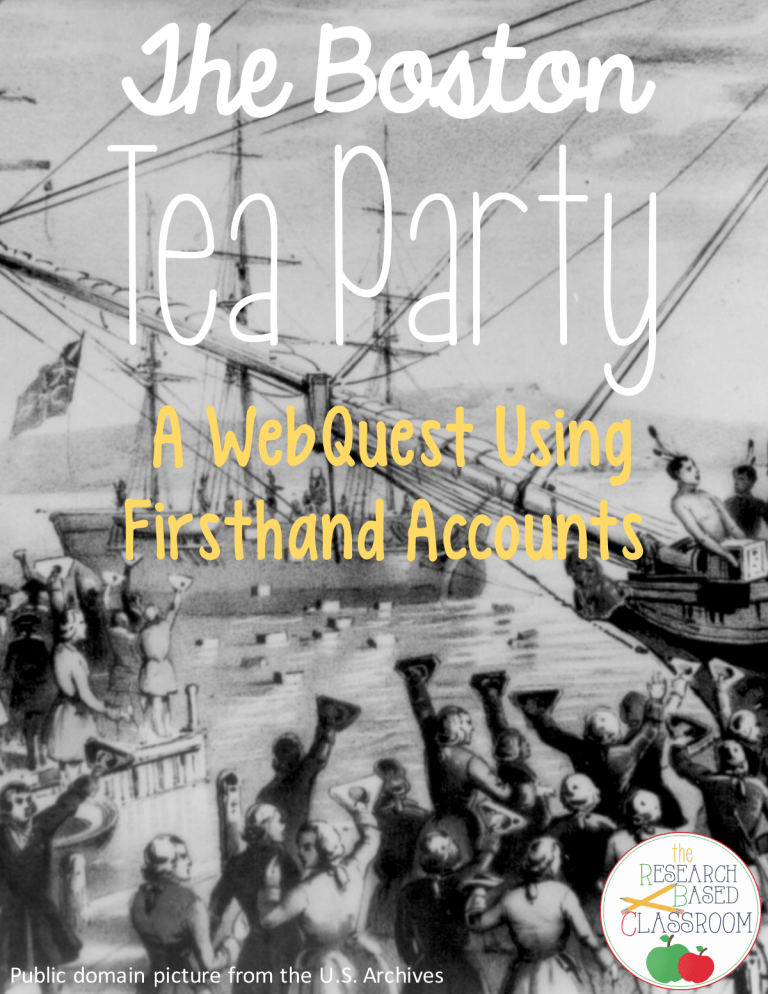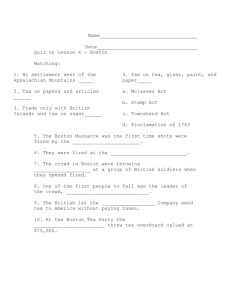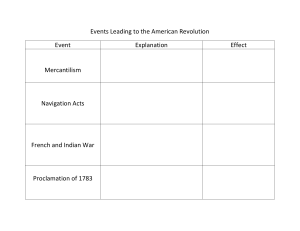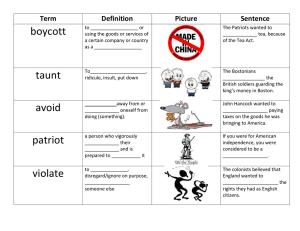
The Boston Tea Party A WebQuest Using Firsthand Accounts Public domain picture from the U.S. Archives TO U & Credits Copyright ©2015 Brandi Wayment a.k.a. The Research Based Classroom All rights reserved by author Permission to copy for single classroom use only A great big thanks to all the talented people who made my ideas look good! 0215208664 Boston Tea Party WEbQuest Notes • Devices: Each small group of students will need access to a device that can use a QR code reader. You can find many different QR code reader apps for free. If you don’t have devices in your classroom, consider having students bring their own. This activity could also take place in a center to limit the number of devices needed. • I usually include the following in the timeline of events leading up to the Boston Tea Party: 1763 End of the French and Indian War, 1764 The Sugar Act, 1765 The Stamp Act, 1765 The Stamp Act Congress, 1767 Townshend Acts, 1770 The Boston Massacre • I like to have my students sign up for a participant to talk about on page 7. That way we learn about more of the participants. On a computer, there are links for each person on the list that you find through the QR code. The links are very short and tell what happened to each person after the Boston Tea Party. However, on an iPad, iPhone or iPod, they do not show as links. To resolve this issue, I had my students click on the person of their choice on the computer and quickly read what happened to them. Your students could also look them up on other websites and do their own research. After everyone was done, we introduced ourselves as the actual participants and told what happened to each person after the Boston Tea Party. Students wrote out a few sentences on page 7 that they then read to the class. • Answers will vary on most pages, so I have not given answer keys. After students completed the webquest, we discussed their findings, talked about their remaining questions and had a great classroom discussion about the Boston Tea Party. King George III and Parliament wanted to punish the colonies for this act. Create a list of pros and cons for punishing the colonies. In support of punishment for the colonies Against punishment for the colonies The Boston Tea Party Now put yourself in their shoes. Pretend you are a member of Parliament. Would you vote to punish the colonies? Explain your reasoning. Name: ©2015 The Research Based Classroom Page 8 Page 1 Create a timeline of events that lead up to the Boston Tea Party. What do you think caused the differences in the accounts? Now choose a person who participated in the Boston Tea Party. Read about him and be prepared to tell the class about his life. Hello, I am __________________________. Page 2 Page 7 Many depictions of the Boston Tea Party exist. Look through the pictures carefully, note both the differences and similiarities between them. The first published account of the Boston Tea Party given by a participant was Joshua Wyeth’s. He was sixteen years old on the night of the Boston Tea Party, although he did not tell his story until 53 years after it occurred. Write down the important details of this account. Page 6 Page 3 More than 50 years after the event, George Hewes gave his eyewitness account of the event. In 1850 David Kinnison gave his account of the event. Why do you think some of the men tried to save some tea and why were they not allowed to take any of the tea? This account has a lot of information that conflicts with the previous accounts. What differences do you find? Page 4 Page 5 Connect with Me Visit my TpT Store Thank you for downloading this product. I love to receive feedback, questions and suggestions. Please email me at: theresearchbasedclassroom@gmail.com




